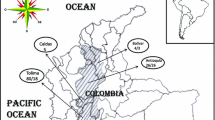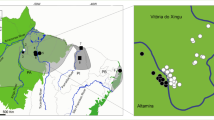Abstract
The genetic variability of New World primates is still poorly documented. We present the first genetic study on two threatened endemic titi monkey species in northern Bolivia (Plecturocebus modestus and Plecturocebus olallae) using six microsatellite markers to investigate genetic structure and variability of 54 individuals from two wild populations. A low level of genetic diversity was found (34 alleles in the total sampled population). Locus 1118 presented the greatest number of alleles. The mean number of alleles per locus in the total population was 5.6 and the average heterozygosity was 0.38 (range 0.12–0.88). The FIS value for the total population using all microsatellite loci shows a statistically significant heterozygote deficit. The inbreeding coefficients (FIS) were positive and significantly different from zero (0.064 for P. olallae and 0.213 for P. modestus). The genetic differentiation between populations (FST) was moderate with a pair-wise FST estimate of 0.14. Population structure analyses assigned the two populations to two differentiated clusters (K = 2). These results suggest that these two species with very close distributional ranges arose from a single population, and that they remain in a process of genetic differentiation and speciation. This study further underlines the urgent need for conservation actions for both endemic primate species.



Similar content being viewed by others
References
Alcantarino ML, Costa GE, Silva A, Ferrari FF, Cruz Schneider MP (2009) Genetic diversity of red-bellied titis (Callicebus moloch) from Eastern Amazonia based on microsatellite markers. Biochem Genet 47:235–240
Avise JC (2000) Phylogeography: the history and formation of species. Harvard University Press, Cambridge
Belkhir K, Borsa P, Chikhi L, Raufaste N, Bonhomme F (2004) GENETIX 4.05, logiciel sous Windows TM pour la génétique des populations. Montpellier, France: Laboratoire Génome, Populations, Interactions, CNRS UMR 5000, Université de Montpellier II
Bicca-Marques JC, Heymann EW (2013) Ecology and behavior of titi monkeys (genus Callicebus). In: Veiga LM, Barnett AA, Ferrari SF, Norconk MA (eds) Evolutionary Biology and Conservation of Titis, Sakis and Uacaris. Cambridge University Press, Cambridge, pp 196–207
Byrne H, Rylands AB, Carneiro JC, Lynch-Alfaro JW, Bertuol F, Da Silva MNF, Messias M, Groves CP, Mittermeier RA, Farias I, Hrbek T, Schneider H, Sampaio I, Boubli JP (2016) Phylogenetic relationships of the New World titi monkeys (Callicebus): first appraisal of taxonomy based on molecular evidence. Front Zool. https://doi.org/10.1186/s12983-016-0142-4
Byrne H, Lynch Alfaro JW, Sampaio I, Farias I, Schneider H, Hrbek T, Boubli JP (2018) Titi monkey biogeography: parallel Pleistocene spread by Plecturocebus and Cheracebus into a post- Pebas Western Amazon. Zool Scr 2018:1–19
Chikhi L, Goznes B, Treanor A, Bruford MW (2004) Population genetic, structure and inbreeding in an insular cattle breed, the jersey, and its implications for genetic resource management. Heredity 92:396–401
Daltoé A (2006) Caracterização genética de Alouatta caraya (Primates, Atelidae) utilizando marcadores heterólogos do tipo microssatélites. Programas de Pósgraduação em Biología Animal. Universidade de Brasilia, Brazil
Di Fiore A, Fleischer RC (2004) Microsatellite markers for woolly monkeys (Lagothrix lagotricha) and their amplification in other New World primates (Primates: Platyrrhini). Mol Ecol Notes 4:246–249
Doyle JJ, Doyle JL (1987) A rapid DNA isolation procedure for small quantities of fresh leaf tissue. Phytochem Bull 19:11–15
Eguiarte LE (1990) Genética de poblaciones de Astrocaryum mexicanum Liebm. en Los Tuxtlas, Veracruz. Tesis de doctorado, Centro de Ecología, Universidad Nacional Autónoma de México
Ellsworth JA, Hoelzer GA (1998) Characterization of microsatellite loci in a New World primate, the mantled howler monkey (Alouatta palliata). Mol Ecol 7:657–658
Felton A, Felton AM, Wallace RB, Gomez H (2006) Identification, distribution and behavioural observations of the titi monkeys Callicebus modestus Lönnberg 1939, and Callicebus olallae Lönnberg 1939. Primate Conserv 20:41–46
García del Valle Y, Estrada, A, Espinoza E, Lorenzo C, Naranjo E (2005) Genética de poblaciones de monos aulladores (Alouatta pigra) en hábitat continuo y fragmentado en la selva lacandona, México: Un estudio preliminar. Universidad y Ciencia, Num Esp II, pp 55–60. ISSN: 0186-2979. http://www.redalyc.org/articulo.oa?id=15421206
Gilpin ME, Soulé ME (1986) Minimum viable populations: processes of species extinction. In: Soulé ME (ed) Conservation biology: the science of scarcity and diversity. Sinauer, Sunderland, pp 19–34
Groom MJ (2006) Threats to biodiversity. In: Groom MJ, Meffe GK, Carroll CR (eds) Principles of conservation biology. Sinauer Associates inc., Sunderland, pp 63–109
Hershkovitz P (1990) Titis, New World monkeys of the genus Callicebus (Cebidae, Platyrrhini): a preliminary taxonomic review. Fieldiana Zool NS 55:1–109
Holsinger KE, Weir BS (2009) Genetics in geographically structured populations: defining, estimating and interpreting FST. Nat Rev Genet 10:639–650
Kinzey WG (1981) The titi monkeys, genus Callicebus. In: Coimbra-Filho AF, Mittermeier RA (eds) Ecology and Behavior of Neotropical Primates, Vol 1. Academia Brasileira de Ciencias, Rio de Janeiro, pp 240–276
Kobayashi S (1995) A phylogenetic study of titi monkeys, genus Callicebus, based on cranial measurements: i. Phyletic groups of Callicebus. Primates 36:101–120
Lacy RC (1987) Loss of genetic diversity from managed populations: interacting effects of drift, mutation, immigration, selection, and population subdivision. Conserv Biol 1:143–158
Lönnberg E (1939) Notes on some members of the genus Callicebus. Arkiv Für Zoologi 31(13):1–18
López-Strauss H, Wallace RB (2015) Density estimates of two Bolivian primate endemics, Callicebus olallae and C. modestus. Mastozool Neotrop 22:23–34
Martinez J, Wallace RB (2007) Further notes on the distribution of the Bolivian endemic titi monkeys, Callicebus modestus and Callicebus olallae. Neotrop Primates 14:47–54
Martinez J, Wallace RB (2013) New information about the distribution of Callicebus in Bolivia. Ecología en Bolivia 48:57–62
Martinez J, Wallace RB (2016) Plecturocebus olallae. In: Rowe N, Myers M (eds) All the World’s Primates. Pogonias Press Inc, Charlestown, p 201
Martinez J, Wallace RB, Lopez-Strauss H, De La Torre P, Aranibar H (2013) Two new specimens for the Bolivian endemic titi monkeys, Callicebus olallae and Callicebus modestus. Neotrop Primates 20:39–44
Martínez J, Wallace RB (2010) Pitheciidae. In: Wallace RB, Gómez H, Porcel ZR, Rumiz DI (eds) Distribución, Ecología y Conservación de los Mamíferos Medianos y Grandes de Bolivia. Editorial: Centro de Ecología Difusión Simón I. Patiño, Santa Cruz de la Sierra, pp 305–330
Muniz L, Vigilant L (2008) Isolation and characterization of microsatellite markers in the white-faced capuchin monkey (Cebus capucinus) and cross species amplification in other New World monkeys. Mol Ecol Resour 8:402–405
Nei M (1972) Genetic distance between populations. Am Nat 106(949):283–292
Onderdonk DA, Chapman CA (2000) Copying with forest fragmentation: the primates of Kibale National Park, Uganda. Int J Primatol 21:587–611
Pritchard J, Stephens M, Donnelly P (2000) Inference of population structure using multilocus genotype data. Genetics 155:945–959
Raymond ML, Rousset F (1995) An exact test for population differentiation. Evolution 49:1280–1283
Ruíz-García M, Castillo MI, Álvarez D, Gardeazabal J, Borrero LM, Ramírez DM, Carrillo L, Nassar F, Gálvez H (2007) Estudio de 14 especies de primates platirrinos (Cebus, Saimiri, Aotus, Saguinus, Lagothrix, Alouatta y Ateles), utilizando 10 loci microsatélites: análisis de la diversidad génica y de la detección de cuellos de botella con propósitos conservacionistas. Orinoquia 11(2):19–37
Van Roosmalen MGM, Van Roosmalen T, Mittermeier RA (2002) A taxonomic review of the titi monkeys, genus Callicebus Thomas, 1903, with the descriptions of two new species, Callicebus bernhardi and Callicebus stephennashi, from Brazilian Amazonia. Neotrop Primates 10:1–52
Veiga LM, Wallace RB, Martinez J (2008) Callicebus modestus. The IUCN Red list of threatened species, p e.T41550A10498144. http://dx.doi.org/10.2305/IUCN.UK.2008.RLTS.T41550A10498144.en. Downloaded on 28 September 2016
Veiga LM, Wallace RB, Martinez J (2008) Callicebus olallae. The IUCN Red list of threatened species, p e.T3554A9939925. http://dx.doi.org/10.2305/IUCN.UK.2008.RLTS.T3554A9939925.en. Downloaded on 28 September 2016
Wallace RB, Martinez J, Lopez-Strauss H, Barreta J, Reinaga A, Lopez L (2013) Conservation challenges facing two threatened endemic titi monkeys (Callicebus modestus & C. olallae) in a naturally fragmented Bolivian forest. In: Marsh LK (ed) Primate in fragments: complexity and resilience. Developments in primatology: progress and prospects. Springer Science + Business Media, New York, pp 493–501
Weir BS, Cockerham C (1984) Estimating F-statistics for the analysis of population structure. Evolution 38:1358–1370
Woodward SR, King MJ, Chiu NM, Kuchar MJ, Griggs CW (1994) Amplification ancient nuclear DNA from teeth and soft tissues. PCR Methods Appl 13:224–244
Acknowledgements
We thank the Wildlife Conservation Society, Gordon and Betty Moore Foundation, Primate Conservation Inc., Margot Marsh Biodiversity Foundation, BP Conservation Leadership Program, and Conservation International Primate Action Fund for financial support for conservation research efforts on the Bolivian Plecturocebus endemics. We thank our field assistant Hector Cáceres, and also Lesly Lopez who helped in data collection. We thank the National Directorate for the Protection of Biodiversity for help in acquiring necessary research permits, as well as the collaboration of the Municipalities of Reyes, San Borja, and Santa Rosa del Yacuma, and the Nogales cattle ranches for access to the study sites. We acknowledge the support of the Institute of Biology Molecular and Biotechnology (Universidad Mayor de San Andres) in La Paz.
Author information
Authors and Affiliations
Corresponding author
Additional information
Publisher's Note
Springer Nature remains neutral with regard to jurisdictional claims in published maps and institutional affiliations.
Electronic supplementary material
Below is the link to the electronic supplementary material.
About this article
Cite this article
Barreta Pinto, J., Martinez, J., Bernal, Y. et al. Genetic differentiation and diversity of the Bolivian endemic titi monkeys, Plecturocebus modestus and Plecturocebus olallae. Primates 60, 565–573 (2019). https://doi.org/10.1007/s10329-019-00750-z
Received:
Accepted:
Published:
Issue Date:
DOI: https://doi.org/10.1007/s10329-019-00750-z




